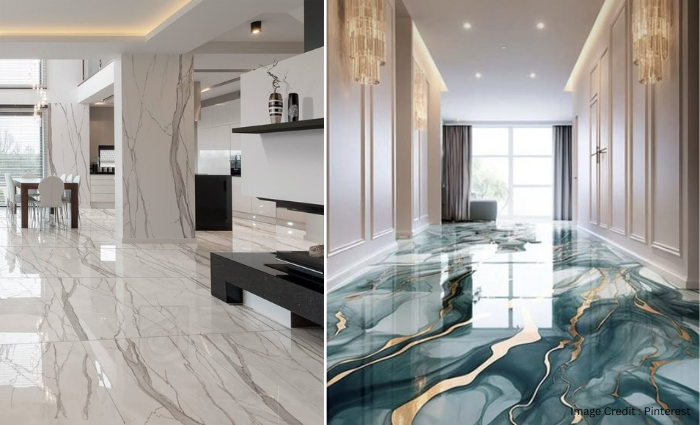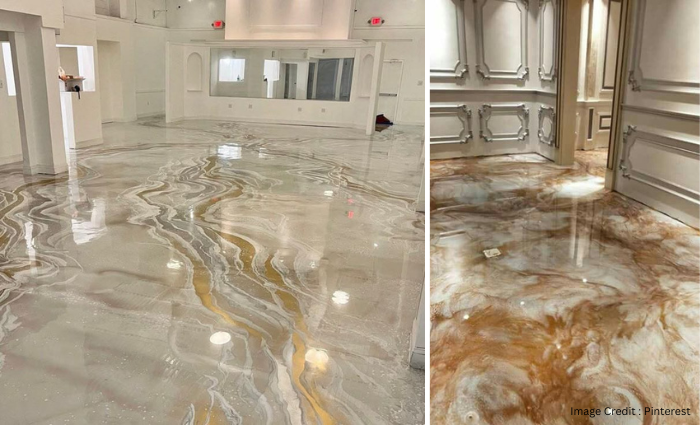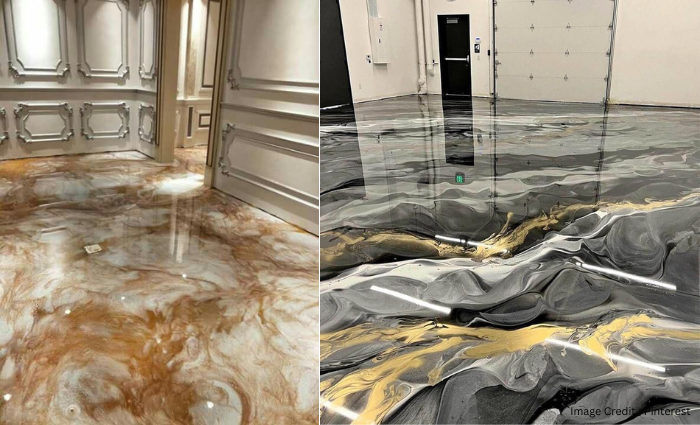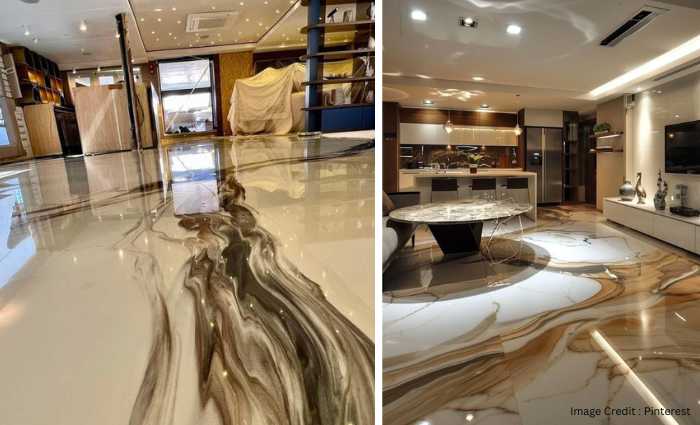When it comes to upgrading your home flooring, epoxy floor paint is trending like never before. Social media is flooded with glossy, seamless epoxy designs — but homeowners are still unsure whether to choose this modern option or stick with traditional tiles or marble.

If you’re one of those wondering whether epoxy floor paint is the right choice for your home, you’re in the right place. In this blog, we’ll break down the key differences between epoxy floor paint and tiles, their types, cost, pros, cons, and insider tips to help you make the right decision in 2025.
What Is Epoxy Floor Paint?
Epoxy floor paint is a smooth, joint-free flooring option created by blending resin with hardening agents. Once applied, it creates a smooth, glossy (or matte) surface without visible joints or grout lines.
Unlike tiles or marble that show gaps or lines between pieces, epoxy floors look like a continuous surface — which is why they’re so aesthetically pleasing and modern.
Types of Epoxy Floor Paint (Residential Focus)
1. Self-Leveling Epoxy
- Ideal for uneven concrete floors
- Commonly used in commercial and industrial spaces
- Plain, single-color finish (no design options)
- Not recommended for home interiors
2. Metallic Epoxy
- Most popular for homes
- Comes in rich, reflective designs
- Requires skilled labor for proper finish
- Available in matte and glossy finishes
3. 3D Epoxy Floor Paint
- Allows printed visuals like fish, flowers, sky, or any graphic
- Often used in kids’ rooms, bathrooms, or feature areas
- Stunning finish, but not preferred for the entire house

Epoxy Floor Paint Installation Process
- Surface must be clean, crack-free, and dry
- Apply a primer layer first to establish a strong connection between the base surface and the epoxy coating.
- Spread the epoxy coating at this stage, where metallic or 3D designs are incorporated.
- Final coat depends on thickness (3mm is ideal for home use)
Note: Ensure the base is even before starting. If your base has old tiles or concrete, it must be repaired and leveled before applying epoxy.
🔹 Cost Comparison – Epoxy Floor Paint vs Tiles
| Flooring Type | Average Cost (per sq. ft.) | Includes Design | Seamless Finish |
|---|---|---|---|
| Basic Tiles | ₹50–₹120 | Limited | ❌ |
| Designer Tiles | ₹120–₹200+ | Medium | ❌ |
| Marble Flooring | ₹200–₹400+ | Natural Veins | ❌ |
| Epoxy Floor Paint | ₹250–₹450 | Fully Customizable | ✅ |
Pro Tip: Go with at least 3mm thickness for durability in homes. Cost includes both material and labor.

🔹 Pros of Epoxy Floor Paint
- ✅ Seamless & Joint-Free Look – No visible gaps like tiles or marble
- ✅ Fully Customizable Designs – Create whatever you imagine
- ✅ Waterproof & Anti-Skid – Safe for bathrooms, kitchens, kids’ rooms
- ✅ Modern & Stylish – Instantly upgrades the interior feel
- ✅ Low-Maintenance Finish – Its smooth, gap-free surface keeps dust and debris from settling in.
🔹 Cons of Epoxy Floor Paint
- ❌ Elevated Upfront Investment – Costs more compared to regular tile flooring.
- ❌ Difficult to Repair – Scratches or chips require complete recoating
- ❌ Can Yellow in Direct Sunlight – Avoid in balconies or sunlit living rooms
- ❌ Not Ideal for Heavy Furniture Movement – Can scratch easily
🔹 When to Avoid Epoxy Floor Paint
- If your home has heavy-duty furniture that’s often moved
- If the area receives direct sunlight regularly
- If you’re working with a limited budget, particularly for spacious areas
- If you want zero maintenance flooring
🔹 Where Epoxy Floor Paint Works Best in Homes
- Kids’ Rooms
- Bathrooms
- Kitchens
- Study Rooms
- Accent Spaces
- Garage (using self-leveling epoxy)

🔹 Expert Tips Before You Install Epoxy Floor Paint
- Use furniture pads under legs to prevent scratches
- Avoid dragging heavy items — lift instead
- Refreshing the protective coating every few years helps boost durability and extend the life of your flooring.
- Hire experienced contractors for better design and finish
- Don’t use epoxy in areas with direct sunlight exposure
Final Verdict – Epoxy Floor Paint or Tiles?
If you want a modern, seamless, and stylish look with design flexibility, epoxy floor paint is a winner. But if you prefer something budget-friendly, easier to repair, and sunlight-resistant, tiles may still be the better option.
For most modern Indian homes in 2025, metallic epoxy floor paint is gaining huge popularity — especially for feature areas where style matters.
🟢 Need Help with Epoxy Floor Design?
Want to know if epoxy flooring suits your home? Need help with planning or hiring the right team?
👉 Contact our design experts today! Drop a message in the comments or click the link below to connect with our team for a free consultation.
Frequently Asked Questions (FAQs)
Q1. What is epoxy floor paint and how is it different from tiles?
A: Epoxy floor paint offers a smooth, jointless finish using a resin-based formula, creating a continuous and polished surface. Unlike tiles, which are laid piece by piece and show grout lines, epoxy creates a continuous finish with custom designs, high durability, and waterproof properties.
Q2. Is epoxy floor paint suitable for Indian homes?
A: Yes, epoxy floor paint is becoming increasingly popular in Indian homes, especially for kitchens, bathrooms, kids’ rooms, and stylish living areas. It works well in places where waterproofing, anti-skid properties, and easy maintenance are essential.
Q3. Does epoxy flooring get scratched or damaged easily?
A: Epoxy floors are durable, but metallic epoxy can get scratched if heavy furniture is dragged across it. Using furniture pads and avoiding direct sun exposure can help maintain its finish. Light foot traffic does not cause damage.
Q4. How long does epoxy floor paint last in homes?
A: With proper installation and occasional protective top coats, epoxy flooring can last 7–10 years or more in residential spaces. In low-traffic areas, the lifespan can be even longer.
Q5. Is epoxy floor paint better than tiles for long-term use?
A: It depends on your needs. Epoxy is seamless, stylish, and waterproof but costs more and is harder to repair. Tiles are cheaper, easier to replace, but show joints and may not offer the same modern look.
